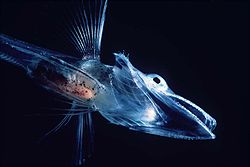- Channichthyidae
-
Crocodile icefish 
Icefish larva Scientific classification Kingdom: Animalia Phylum: Chordata Class: Actinopterygii Order: Perciformes Suborder: Notothenioidei Family: Channichthyidae Genera Chaenocephalus
Chaenodraco
Champsocephalus
Channichthys
Chionobathyscus
Chionodraco
Cryodraco
Dacodraco
Neopagetopsis
Pagetopsis
PseudochaenichthysThe crocodile icefish or white-blooded fish (Channichthyidae) are a family of perciform fish found in the cold waters around Antarctica and southern South America. Water temperature can drop below 0°C (the freezing point of freshwater) in the Antarctic sea, but, stays rather constant. There are sixteen known species of crocodile icefish. They feed on krill, copepods, and other fish.
Contents
Blood
Their blood is transparent because it contains less than 10% hemoglobin and/or only defunct red blood cells.[1] Oxygen is absorbed directly through their scaleless skin from the water. It is then dissolved in the plasma and transported throughout the body without the hemoglobin protein. The loss of hemoglobin is not fatal because of the cold environment in which channichthyids live. Cold water has a much higher dissolved oxygen content than warmer water [2]
Hemoglobin
Channichthyidae are the only known vertebrates without hemoglobin, an oxygen transport protein in the blood. Although they do not manufacture hemoglobin, remnants of hemoglobin genes can be found in their genome. The hemoglobin protein is made of two subunits (alpha and beta). Almost all of the alpha and beta subunit genes have been lost from the genomes of 15 of the 16 icefish species.[3][4][5] In only one of the icefish species, Neopagetopsis ionah, there is a more complete, but still nonfunctional hemoglobin gene.[6]
Hemoglobin loss was probably not adaptive because icefish had to develop many more adaptations to compensate for the loss of the oxygen transporting protein. They increased their blood volume and heart size, and lowered their metabolic rates and their oxygen demand in tissues.[7][8]
Myoglobin
Myoglobin is an oxygen transport protein used in muscles, but is also absent from all icefish skeletal muscles. In ten species, myoglobin is found in the heart muscle, specifically ventricles.[9] Myoglobin has been lost in icefish heart ventricles at least four separate times and by four different mechanisms.[10]
References
- ^ Ruud, J. T. 1954. Vertebrates without erythrocytes and blood pigment. Nature 173:848-850.
- ^ Giordano, D., L. Boechi, A. Vergara, M. Marti, U. Samuni, D. Dantsker, L. Grassi, D. Estrin, J. Friedman, L. Mazzarella, G. di Prisco, and C. Verde. 2009. The hemoglobins of the sub-Antarctic fish Cottoperca gobio, a phyletically basal species - oxygen-binding equilibria, kinetics, and molecular dynamics. The FEBS Journal 276:2266-2277.
- ^ Zhao, Y. Q., M. Ratnayake-Lecamwasam, S. K. Parker, E. Cocca, L. Camardella, G. di Prisco, and H. W. Detrich. 1998. The major adult alpha-globin gene of antarctic teleosts and its remnants in the hemoglobinless icefishes-calibration of the mutational clock for nuclear genes. Journal of Biological Chemistry 273:14745-14752.
- ^ di Prisco, G., E. Cocca, S. K. Parker, and H. W. Detrich. 2002. Tracking the evolutionary loss of hemoglobin expression by the white-blooded antarctic icefishes. Gene 295:185-191.
- ^ di Prisco, G., J. T. Eastman, D. Giordano, E. Parisi, and C. Verde. 2007. Biogeography and adaptation of notothenioid fish: hemoglobin function and globin-gene evolution. Gene 398:143-155.
- ^ Near, T. J., S. K. Parker, and H. W. Detrich. 2006. A genomic fossil reveals key steps in hemoglobin loss by the antarctic icefishes. Molecular Biology and Evolution 23:2008-2016.
- ^ Feller, G., and C. Gerday. 1997. Adaptations of the hemoglobinless antarctic icefish (Channichthyidae) to hypoxia tolerance. Comparative Biochemistry and Physiology A-Molecular and Integrative Physiology 118:981-987.
- ^ Fitch, N. A., I. A. Johnston, and R. E. Wood. 1984. Skeletal-muscle capillary supply in a fish that lacks respiratory pigments. Respiration Physiology 57:201-211.
- ^ Sidell, B. D., M. E. Vayda, D. J. Small, T. J. Moylan, R. L. Londraville, M. L. Yuan, K. J. Rodnick, Z. A. Eppley, and L. Costello. 1997. Variable expression of myoglobin among the hemoglobinless antarctic icefishes. Proceedings of the National Academy of Sciences of the United States of America 94:3420-3424.
- ^ Sidell, B. D., and K. M. O’Brien. 2006. When bad things happen to good fish: the loss of hemoglobin and myoglobin expression in antarctic icefishes. Journal of Experimental Biology 209:1791-1802.
External links
Categories:
Wikimedia Foundation. 2010.
